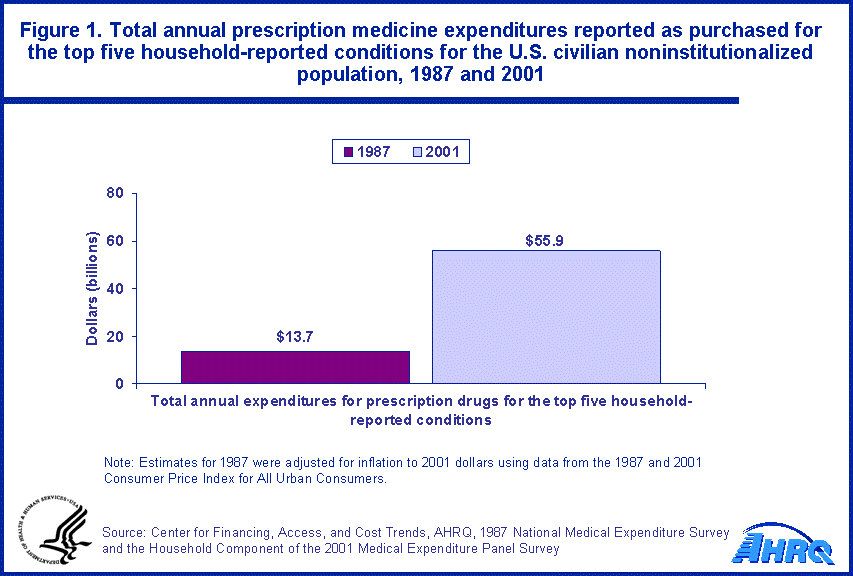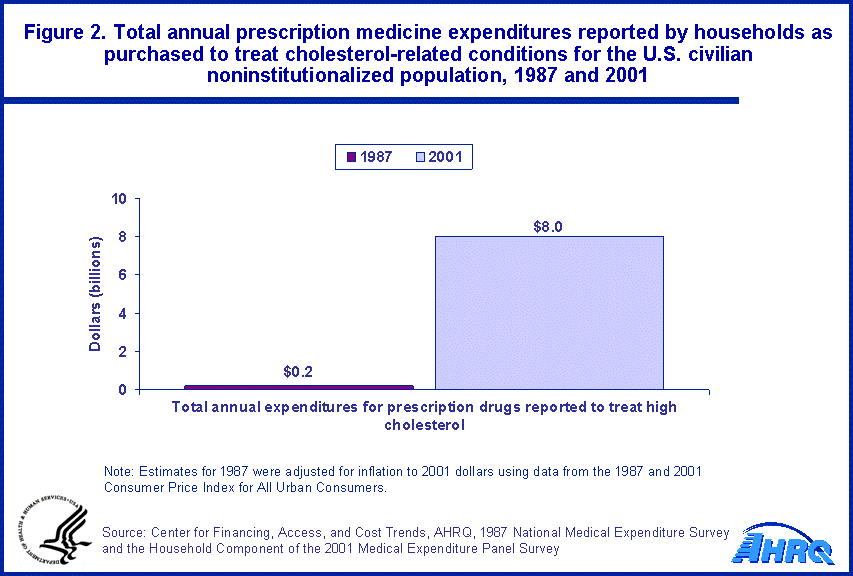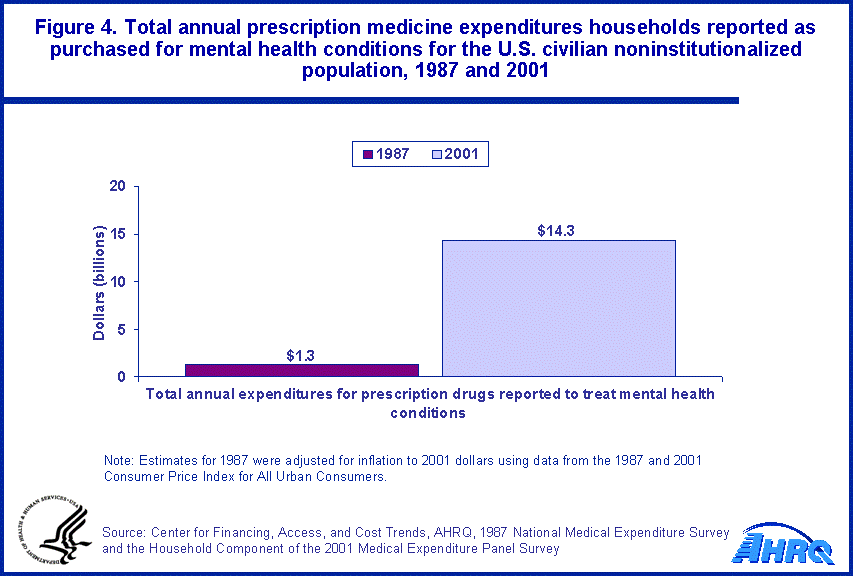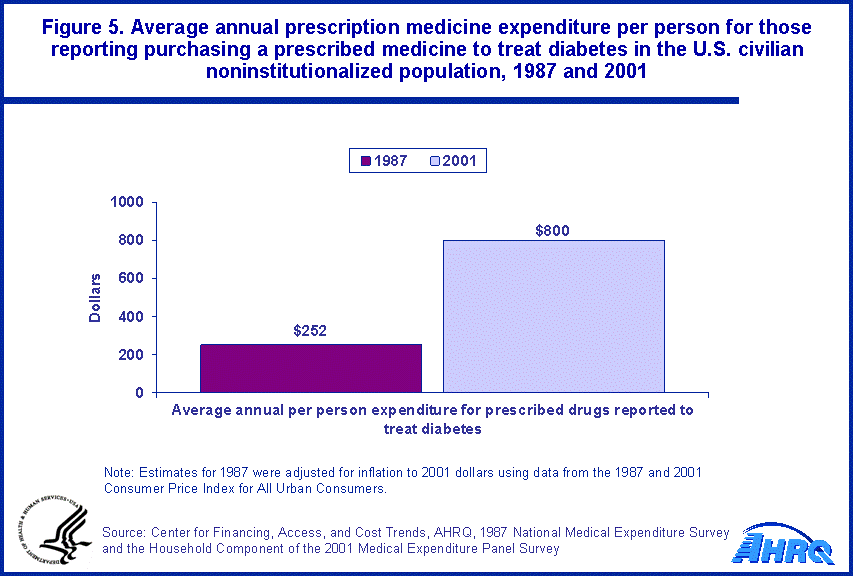
|
|
Font Size:
|
||||
|
|
|
|
||||
STATISTICAL BRIEF #43:
Outpatient Prescription Medicines: A Comparison of Expenditures by Household-Reported Condition, 1987 and 2001
Highlights
- Prescribed drugs reported as purchased to treat the top five household-reported conditions as ranked by total annual prescribed drug expenditures increased from $13.7 billion (in 2001 dollars) in 1987 to $55.9 billion in 2001.
- Cholesterol-related prescription drug purchases rose from $0.2 billion (in 2001 dollars) in 1987 to $8 billion in 2001.
- The average annual prescription medicine expenditure per person for those reporting purchasing a cholesterol-reducing drug more than doubled from 1987 to 2001: $240 (in 2001 dollars) versus $542, respectively.
- Total annual expenditures for prescribed drugs reported by households to treat mental health conditions increased more than tenfold from $1.3 billion (in 2001 dollars) in 1987 to $14.3 billion in 2001.
- The average annual expenditure per person for prescribed medicines reported by households as purchased to treat diabetes rose from $252 (in 2001 dollars) in 1987 to $800 in 2001.
Introduction
This Statistical Brief summarizes differences in expenditures for outpatient prescription medicines reported for specific conditions by the household in the U.S. civilian noninstitutionalized population for the years 1987 and 2001. The brief further analyzes data provided in Statistical Brief #33, Outpatient Prescribed Medicines: A Comparison of Utilization and Expenditures, 1987 and 2001, by providing expenditure rankings for prescribed drugs that households reported as purchased to treat specific conditions.
The data used to estimate the proportion of the population that had prescribed medicine expenditures are derived from the 1987 National Medical Expenditure Survey (NMES) and the Household Component of the 2001 Medical Expenditure Panel Survey (MEPS-HC). The estimates from the 1987 NMES were adjusted for inflation using data from the 1987 and 2001 Consumer Price Index for All Urban Consumers (CPI-U). All significance tests were done using the adjusted 1987 estimates and the 2001 estimates, and all results discussed are statistically significant at the 0.05 level. Over-the-counter medicines and free samples are not included in these estimates. Conditions in this brief are household-reported conditions that are coded by professional medical coders using the International Classification of Diseases, Ninth Revision (ICD-9).
Findings
In 1987, the top five household-reported conditions related to a prescribed drug purchase as ranked by total annual expenditures totaled $13.7 billion (in 2001 dollars) and included the following:
| 1987 Top Five Household-Reported Conditions Related to a Prescribed Drug Purchase | Total Annual Expenditures |
| 1. High blood pressure | $5.5 billion* |
| 2. Heart disease | $3.5 billion* |
| 3. Arthritis | $1.9 billion* |
| 4. Diabetes | $1.5 billion* |
| 5. Asthma | $1.3 billion* |
| Total of Top Five Conditions | $13.7 billion* |
| * in 2001 dollars | |
In 2001, the top five household-reported conditions related to a prescribed drug purchase as ranked by total annual expenditures totaled $55.9 billion and included the following:
| 2001 Top Five Household-Reported Conditions Related to a Prescribed Drug Purchase | Total Annual Expenditures |
| 1. High blood pressure | $15.1 billion |
| 2. Mental health disorders | $14.3 billion |
| 3. Diabetes | $9.5 billion |
| 4. Asthma | $9.0 billion |
| 5. High cholesterol | $8.0 billion |
| Total of Top Five Conditions | $55.9 billion |
(figure 1)
Prescription drug expenditures for the top five household-reported conditions in 1987 represented 39.5 percent of the $34.7 billion (in 2001 dollars) total expenditures for prescription drugs reported to treat a condition. In 2001, prescription drug expenditures for the top five household-reported conditions represented 41.7 percent of the $134.1 billion total expenditures for prescription drugs reported to treat a condition. The following three household-reported conditions related to a prescribed drug purchase ranked among the top five in both 1987 and 2001: high blood pressure, diabetes, and asthma.
When comparing the 1987 and 2001 rankings of total annual prescription drug expenditures related to a household-reported condition, drugs reported as purchased for a cholesterol-related condition jumped considerably from over thirtieth to fifth in rank. Cholesterol-related prescription drug purchases were markedly higher in 2001 than in 1987--$8 billion versus $0.2 billion (in 2001 dollars), respectively (figure 2). In 1987, those persons reporting having purchased a prescribed medicine for a cholesterol-related condition had an average annual prescription medicine expenditure of $240 (in 2001 dollars) per person. In 2001, this average annual prescription medicine expenditure more than doubled to $542 (figure 3).
In 1987, prescribed drugs reported as purchased to treat mental heath disorders ranked sixth in total annual prescription drug expenditures related to a household-reported condition and totaled $1.3 billion (in 2001 dollars). Comparatively, in 2001, prescribed drugs reported to treat mental health disorders ranked second in total annual prescription drug expenditures related to a household-reported condition and totaled $14.3 billion (figure 4).
In 1987, prescribed drugs reported as purchased to treat arthritis ranked third in total annual prescription drug expenditures related to a household-reported condition ($1.9 billion in 2001 dollars). In 2001, prescription drugs reported as purchased to treat arthritis fell to eighth in the ranking of total annual prescription drug expenditures related to a household-reported condition ($ 6.0 billion).
Prescribed drugs reported as purchased to treat high blood pressure ranked highest in terms of total annual prescribed drug expenditures related to a household-reported condition in both 1987 and 2001. In 1987, total annual prescription drug expenditures reported as purchased to treat high blood pressure totaled $5.5 billion (in 2001 dollars). By 2001, total annual prescription drug expenditures reported as purchased to treat high blood pressure nearly tripled to $15.1 billion.
In 1987, prescribed drugs reported as purchased by households to treat persons with diabetes had an average annual expenditure per person of $252 (in 2001 dollars). In 2001, the average expenditure per person reporting purchasing a prescribed medicine to treat diabetes more than tripled to $800 (figure 5).
When comparing the 1987 and 2001 rankings of total annual prescription drug expenditures related to a household-reported condition, prescribed drugs reported as purchased for heart disease fell from second ($3.5 billion, in 2001 dollars) to ninth ($5 billion) in rank.
Methodology
Condition categories were aggregated into clinically meaningful categories by using Clinical Classification Software (CCS), which was formerly known as Clinical Classifications for Health Policy Research (CCHPR). Condition-related expenditures are based on household respondents purchasing a prescribed medicine for a reported condition and were computed based on a two-step methodology. First, total expenditures for prescription medicines related to a condition were estimated and ranked. This initial ranking included double counting for a small percentage of prescription drug expenditures in 2001 and 1987 (3.4 percent in 2001 and 1.5 percent in 1987). Second, the double counting was removed from the ranking by taking those prescribed drug purchases having more than one reported condition and placing those expenditures in the total for the condition with the highest total expenditure based on the initial ranking, and then the conditions were re-ranked.
About MEPS and NMES
The Medical Expenditure Panel Survey (MEPS) is the third in a series of nationally representative surveys of medical care use and expenditures. MEPS is cosponsored by the Agency for Healthcare Research and Quality and the National Center for Health Statistics. MEPS collects nationally representative data on health care use, expenditures, sources of payment, and insurance coverage for the U.S. civilian noninstitutionalized population. The first survey, the National Medical Care Expenditure Survey (NMCES) was conducted in 1977; and the second survey, the National Medical Expenditure Survey (NMES), was carried out in 1987.
NMES and MEPS data are released to the public in public use data files. NMES data files are available from the AHRQ Publications Clearinghouse (E-mail: ahrqpubs@ahrq.gov). MEPS data files are available on the MEPS Web site (http://www.meps.ahrq.gov/).
References
For a detailed description of the MEPS-HC survey design, sample design, and methods used to minimize sources on nonsampling error, see the following publications:
Cohen, J. Design and Methods of the Medical Expenditure Panel Survey Household Component. MEPS Methodology Report No. 1. AHCPR Pub. No. 97-0026. Rockville, Md.: Agency for Health Care Policy and Research, 1997.
Cohen, S. Sample Design of the 1996 Medical Expenditure Panel Survey Household Component. MEPS Methodology Report No. 2. AHCPR Pub. No. 97-0027. Rockville, Md.: Agency for Health Care Policy and Research, 1997.
For more information on the method in which clinical classification codes were aggregated into meaningful categories, please see the following:
Elixhauser, A. et al. Clinical Classifications for Health Policy Research: Hospital Inpatient Statistics, 1996. Health Care Utilization Project, HCUP-3 Research Note, Pub. No. 98-0049 Rockville, Md.: Agency for Healthcare Research and Quality, 2000. (Clinical Classification software was formerly Clinical Classification for Health Policy Research.)
These publications are available on the MEPS Web site: http://www.meps.ahrq.gov/.
For more information on the NMES survey design, see the following publications:
Cohen, S., R. DiGaetano, and J. Waksberg. Sample design of the 1987 Household Survey. AHCPR Pub. No. 91-0037. National Medical Expenditure Survey Methods 3. Agency for Healthcare Policy and Research. Rockville, Md.: U.S. Department of Health and Human Services, Public Health Service, 1991.
Edwards, W. and M. Berlin. Questionnaires and data collection methods for the household survey and the survey of American Indians and Alaskan Natives. DHHS Pub. No. (PHS) 89-3450. National Medical Expenditure Survey Methods 2. National Center for Health Services Research and Health Care Technology Assessment. Rockville, Md.: U.S. Department of Health and Human Services, Public Health Service, 1989.
Cohen, J. and N. Krauss. "Spending and service use among people with the fifteen most costly medical conditions, 1997." Health Affairs. March/April 2003, 129-138.
Suggested Citation
Stagnitti, M. and Pancholi, M. Outpatient Prescription Medicines: A Comparison of Expenditures by Household-Reported Condition, 1987 and 2001. Statistical Brief #43. July 2004. Agency for Healthcare Research and Quality, Rockville, MD. http://www.meps.ahrq.gov/mepsweb/data_files/publications/st43/stat43.shtml
 |
||||||||||||
|
||||||||||||
|
|
||||||||||||
 |
||||||||||||
|
||||||||||||
|
|
||||||||||||
 |
||||||||||||
|
||||||||||||
|
|
||||||||||||
 |
||||||||||||
|
||||||||||||
|
|
||||||||||||
 |
||||||||||||
|
||||||||||||
|
|
||||||||||||


